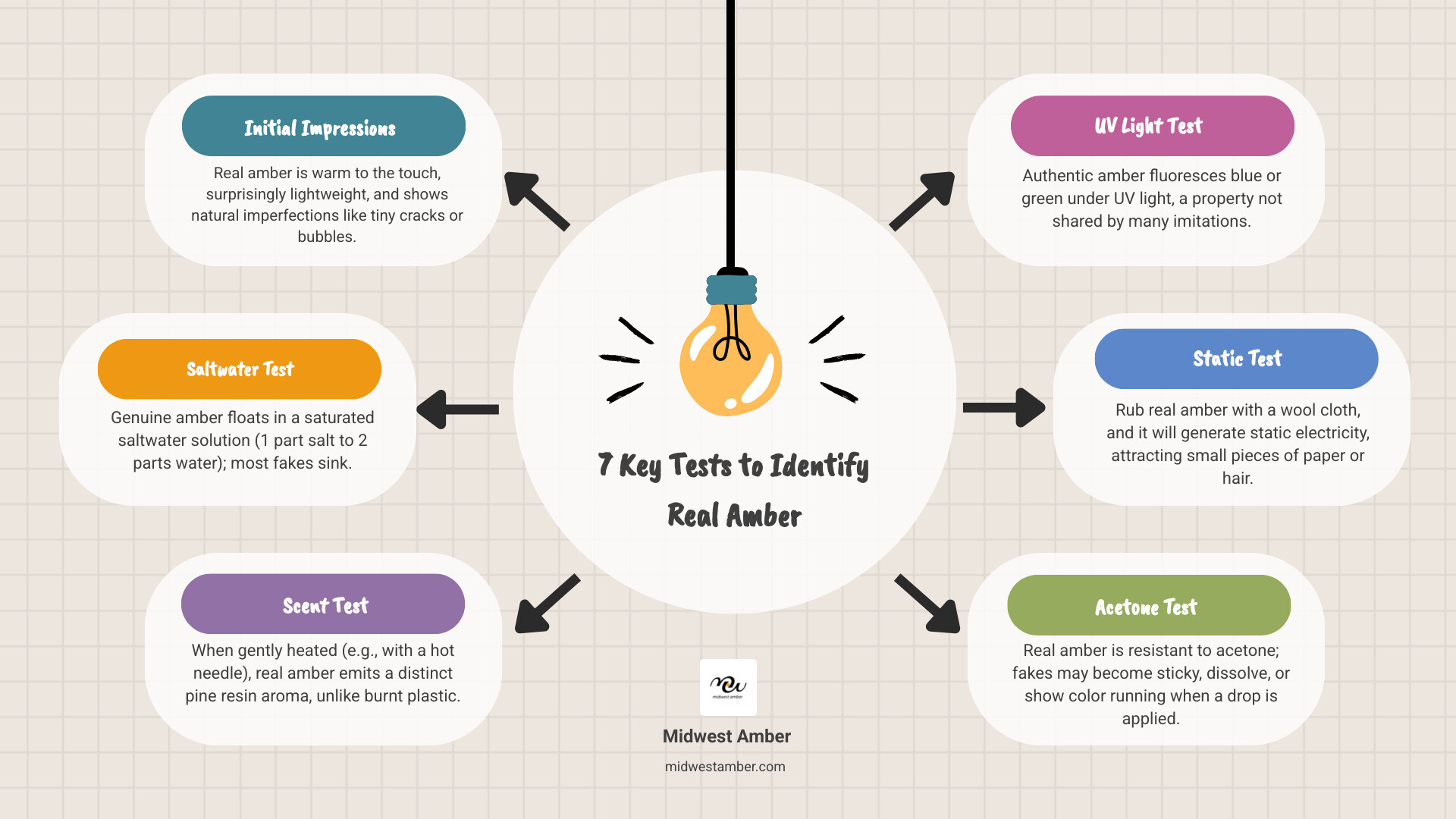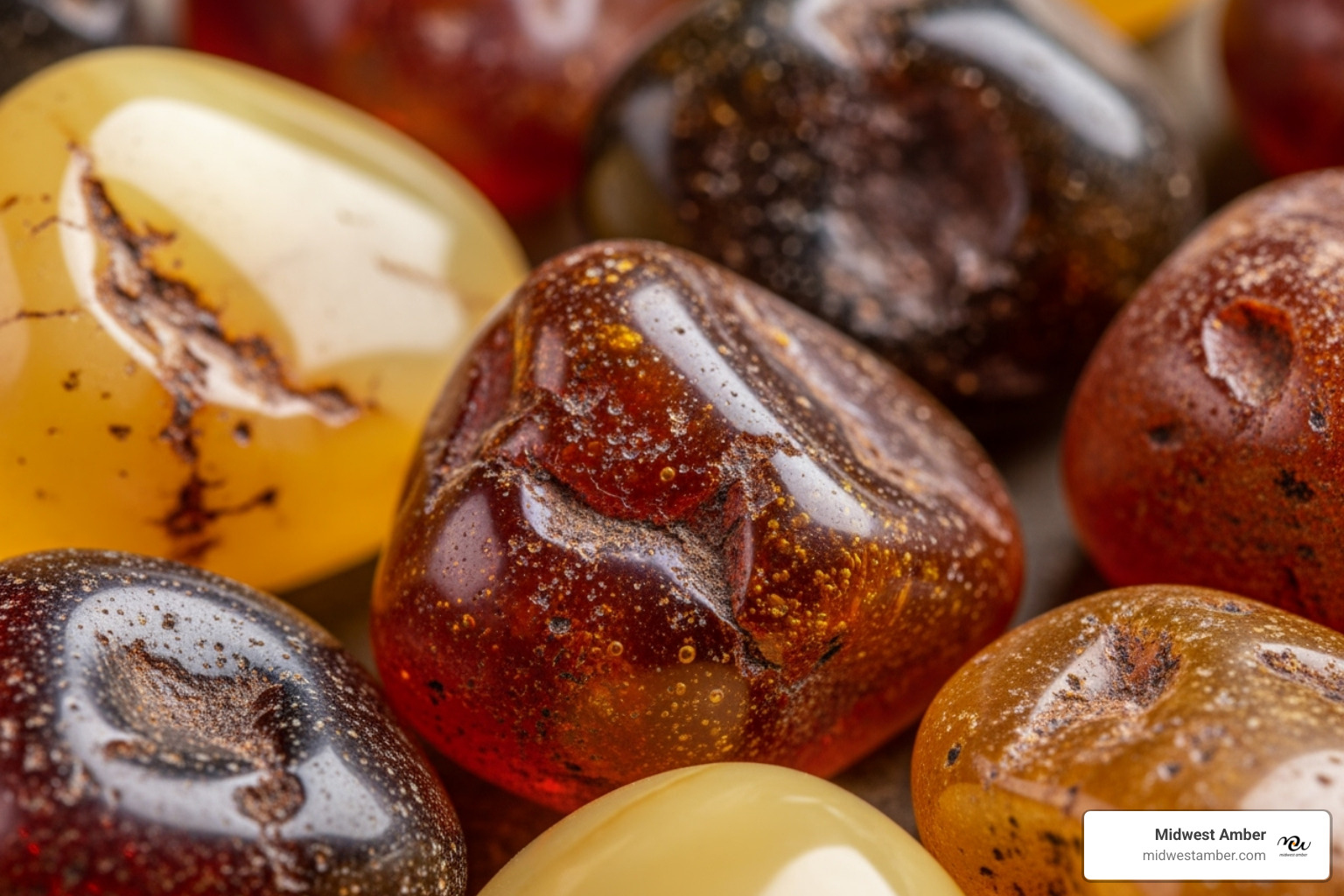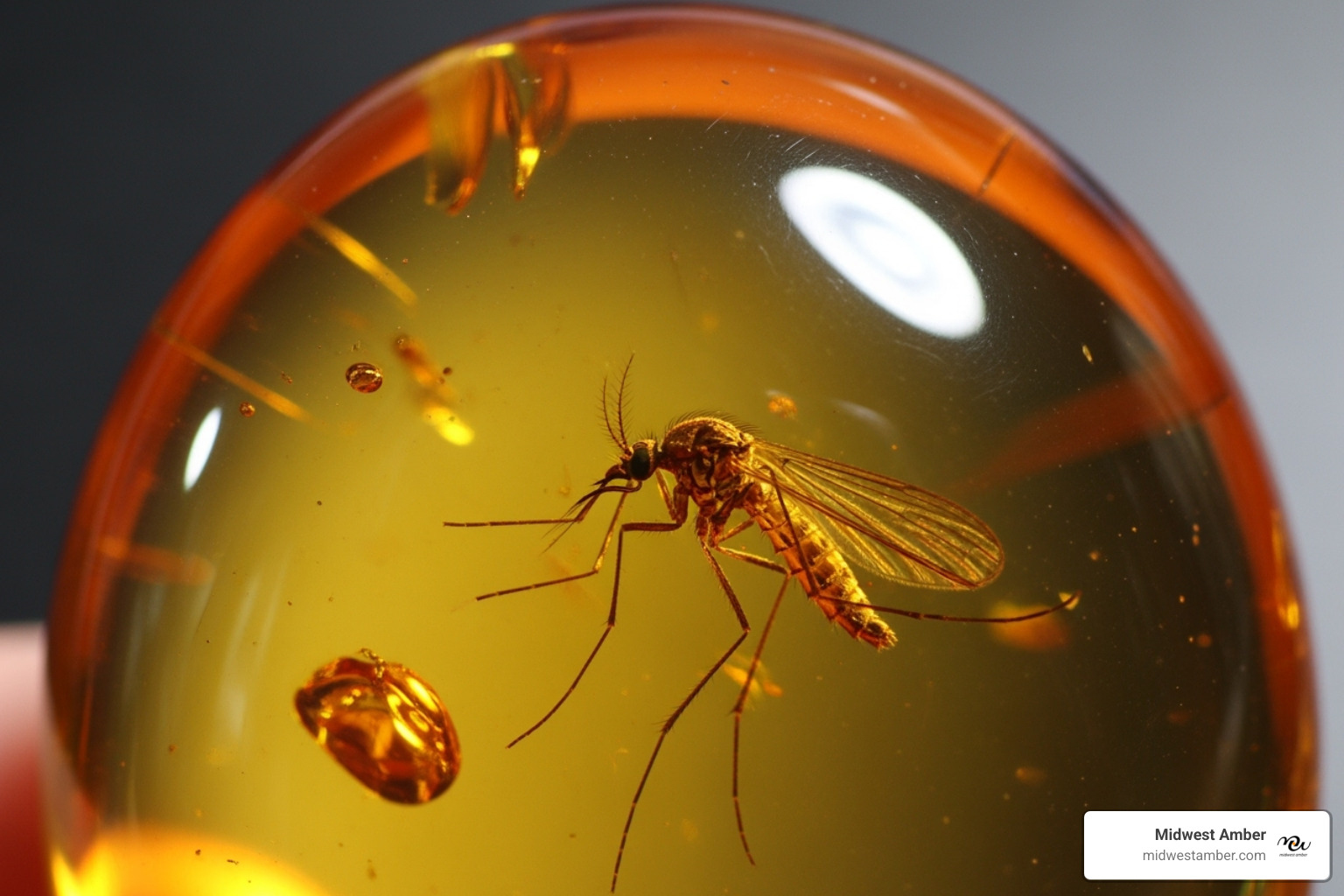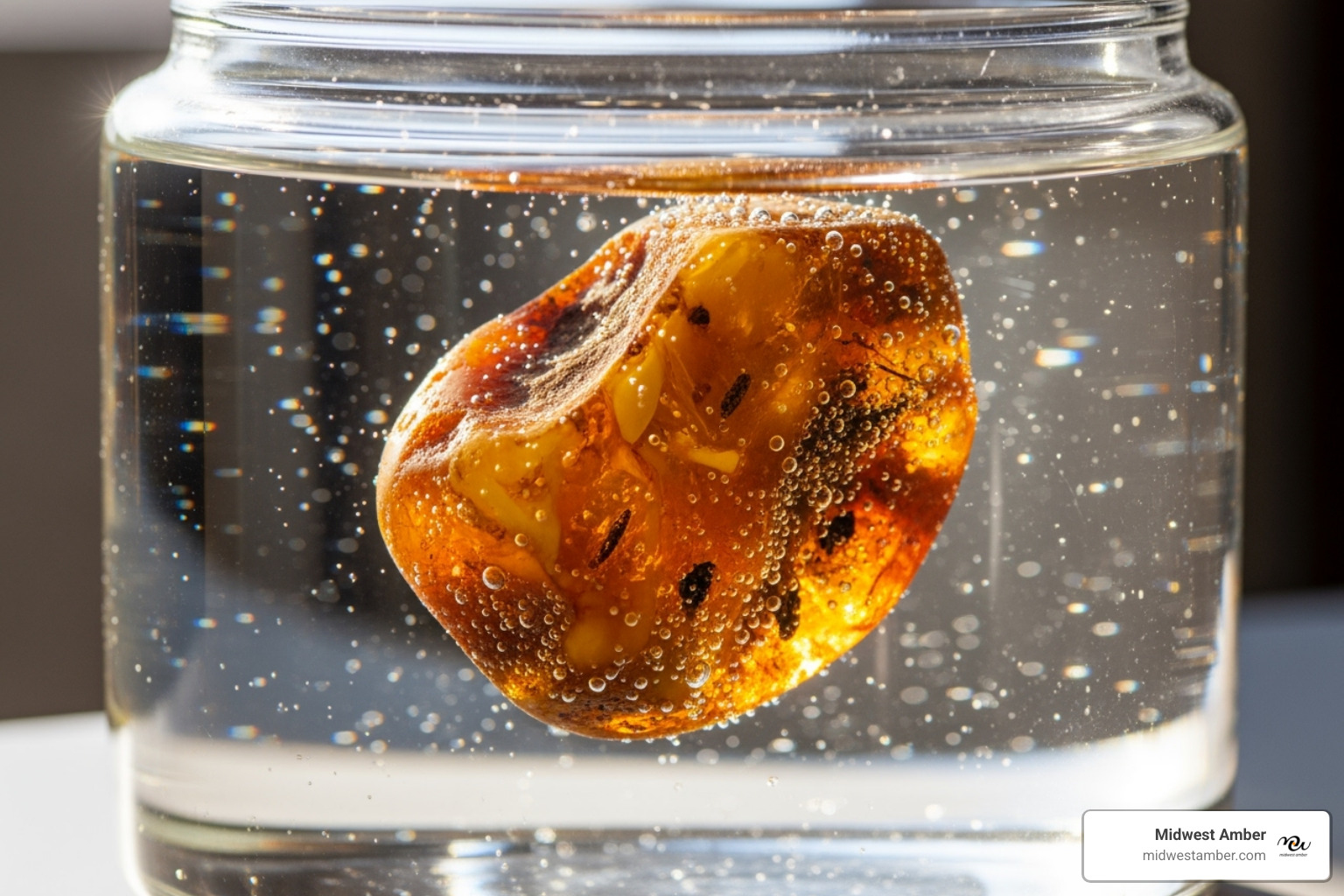Why Authenticity Matters When Buying Amber Jewelry
Learning how to tell real amber jewelry from fakes is crucial, as sophisticated imitations made from plastic, glass, and young resins are common. With amber's popularity, knowing how to spot a counterfeit protects your investment.
Quick Answer: 7 Key Tests to Identify Real Amber Jewelry
- Saltwater Test - Real amber floats in salt water (1 part salt to 2 parts water).
- Scent Test - Genuine amber smells like pine resin when heated, not plastic.
- Feel Test - Real amber is warm to the touch and lightweight.
- UV Light Test - Authentic amber glows blue or green under UV light.
- Static Test - Real amber creates static electricity when rubbed with cloth.
- Visual Check - Look for natural imperfections like air bubbles and inclusions.
- Acetone Test - Real amber resists solvents; fakes become sticky.
Amber is fossilized tree resin, a unique treasure from ancient forests. Unlike synthetics, genuine amber carries the warmth of time and nature's imperfections.
The stakes are high when buying amber. Real Baltic amber contains succinic acid and natural properties that fakes cannot replicate. Whether for yourself or as a gift, these authentication methods ensure you get the genuine article.
As Gabriel Ciupek, President of Midwest Amber Inc., I've spent years in the Baltic amber industry. My experience has taught me that understanding how to tell real amber jewelry is essential for anyone seeking genuine pieces with true historical significance.

First Impressions: Simple Visual and Sensory Checks
Before performing any scientific tests, your own senses can reveal clues about authenticity. Learning how to tell real amber jewelry starts with simple observations.

Genuine amber is nature's imperfect masterpiece. After millions of years underground, it carries beautiful quirks that factories cannot replicate. These "flaws" are your best friends when identifying authentic pieces. Look for tiny cracks, air bubbles, and natural inclusions that tell the story of ancient forests.
To understand more about what makes Baltic amber unique, check out What is Baltic Amber? for a deeper dive into its fascinating origins.
Visual Cues: The First Step in How to Tell Real Amber Jewelry
Your eyes are powerful tools. Real amber has a range of natural colors—warm yellows, rich oranges, and deep browns—that flow and blend naturally, unlike the uniform look of fakes.
Look for imperfect shapes and surface textures. Even polished amber retains subtle irregularities and organic curves. The most exciting finds are natural inclusions like plant matter or tiny insects frozen in time. Air bubbles in real amber are typically round and scattered randomly.
Each bead in genuine amber jewelry is unique. While beads in a necklace are similar in size, they won't be identical. Slight variations in shape and internal patterns are desirable signs of authenticity.

Photo by Joel E. Arem, PhD, FGA. Used with permission.
The Feel Test: Weight and Temperature
Genuine amber warms quickly to your touch, absorbing body heat in a way glass cannot. It also has a surprisingly lightweight feel due to its low density. If your jewelry feels heavy like stone, it's likely not real amber.
When rubbed, real amber can feel slightly sticky when warm, a reminder of its resinous past. This combination of warmth and lightness is often described as a plastic-like feel, but unlike plastic, genuine amber holds your body heat.
At-Home Lab: 7 Tests for How to Tell Real Amber Jewelry
These simple, at-home tests can help you determine how to tell real amber jewelry from imitations. For best results, use a combination of these methods.
The Saltwater Test
This popular test uses amber's unique low density. Real amber has a specific gravity of around 1.08, making it buoyant in saltwater.
How to Perform:
- Dissolve salt in a cup of warm water until no more dissolves (a ratio of 1 part salt to 2 parts water works well).
- Gently place your amber piece into the solution.
Expected Results:
- Real amber will float.
- Most fakes like glass, plastic, or copal will sink.
Limitations: This test isn't foolproof. Some lightweight plastics can float, and metal clasps or heavy cords will cause genuine amber to sink. Test individual beads for best results.
For a deeper dive into amber's properties, see The Ultimate Guide to Baltic Amber.

The Scent and Hot Needle Test
This test is highly definitive but requires caution as it can damage the piece.
How to Perform Safely:
- Perform on an inconspicuous spot (e.g., a drill hole).
- Heat the tip of a needle until red-hot.
- Gently press the hot tip to the amber for only a second or two.
Expected Results:
- Real amber emits a distinct, pleasant pine-tree resin scent. It may crack slightly but won't melt easily.
- Plastic fakes will melt and produce an acrid, chemical smell.
- Copal (a younger resin) may smell sweeter, like fresh pine, not the deep, earthy scent of true amber.
If you're hesitant to use a hot needle, rubbing the amber vigorously on a cloth may release a faint pine scent.
The Electrostatic Charge Test
This simple, non-destructive test uses amber's natural electrostatic properties.
How to Perform:
- Rub the amber piece vigorously on a wool or silk cloth for 20-60 seconds.
- Hold it close to a small piece of paper or a strand of hair.
Expected Results:
- Real amber will generate enough static charge to attract the object.
- Fakes like glass or most plastics will not create a strong enough charge.
The UV Light Test
This non-destructive test reveals properties invisible to the naked eye.
How to Perform:
- In a dark room, shine a UV lamp (blacklight) onto the amber.
Expected Results:
- Real amber will fluoresce. Baltic amber often glows a distinct pale blue or green. You might even see rare "flow lines."
- Plastic and glass fakes will not fluoresce. Copal may turn a milky white.
The Scratch Test: A Cautious Approach
This test evaluates hardness but can damage your piece. Amber is soft, ranking 2-2.5 on the Mohs hardness scale.
How to Perform:
- Fingernail Test: Real amber should not be scratched by a fingernail. Copal (1.5 Mohs) will scratch.
- Metal Test (Use Extreme Caution): A metal object can scratch real amber, leaving a whitish mark. It will not scratch harder fakes like glass.
Caution: Perform this test only as a last resort on an inconspicuous spot. For context, see the Mohs scale of mineral hardness.
The Acetone (Solvent) Test
This test uses amber's resistance to solvents.
How to Perform Safely:
- Apply a small drop of acetone (nail polish remover) or rubbing alcohol to a hidden spot.
- Let it sit for 3-5 seconds, then wipe it off.
Expected Results:
- Real amber will be unaffected.
- Copal and some plastics will become sticky, tacky, or dull as the surface begins to dissolve.
Know The Fakes: Common Amber Imitations and Treatments
Understanding the difference between genuine amber and its imitators is a key part of learning how to tell real amber jewelry. The market is flooded with convincing fakes, so let's explore the most common ones.
The table below shows how genuine amber compares to its most common imitators across our key tests:
| Property/Test | Real Amber | Copal (Young Resin) | Plastic (General) | Glass |
|---|---|---|---|---|
| Origin | Fossilized tree resin (millions of years old) | Young tree resin (thousands to 1 million years old) | Synthetic polymers | Silica |
| Feel/Temp | Warm, lightweight, slightly sticky when warm | Warm, lightweight, can become tacky when rubbed | Cold, can be heavy or light, often smooth | Cold, heavy, very smooth |
| Scent (Heated) | Distinctive pine-tree resin, pleasant, earthy | Sweeter, "fresh pine," not as deep as amber | Burnt plastic, acrid, chemical | No smell |
| Saltwater Test | Floats | Sinks (most types) | Sinks (most types, some can float if porous) | Sinks |
| UV Light Test | Fluoresces blue/green (lighter amber blues, darker greens) | Little to no fluorescence, may appear milky white | No fluorescence | No fluorescence |
| Scratch Test | 2-2.5 Mohs (won't scratch w/fingernail, can scratch w/metal) | 1.5 Mohs (scratches easily w/fingernail) | Varies (often harder than fingernail, softer than glass) | 5-7 Mohs (cannot scratch w/metal) |
| Acetone Test | Resistant, no change | Becomes sticky/tacky, surface damage | Can dissolve, become sticky, or show no change | No change |
| Inclusions | Natural, organic, irregular, "struggling" insects | Can have inclusions, but often faked (too perfect, large) | Often faked, too large (>10mm), centrally placed, lifeless | None typically, or artificial bubbles |
| Sound (Tooth Test) | Light, plastic-like tap | Light, plastic-like tap | Light, plastic-like tap | Hard rattle |
For more comprehensive information, visit How to Tell Real Amber.
Plastics, Glass, and Other Imitations
Plastic imitations are common. The easiest way to identify them is the scent test; when heated, plastic produces a chemical or burnt plastic odor. Plastic fakes also tend to look too perfect, with uniform colors, perfectly round beads, and artificial-looking inclusions.
Glass imitations feel cold and heavy compared to amber's warmth and lightness. Glass is also much harder (5-7 on the Mohs scale) and cannot be scratched by metal. A gentle tap against a tooth will produce a hard, rattling sound, unlike the softer tap of real amber.
Copal is the most convincing fake because it is also tree resin, just much younger (thousands to a million years old). It hasn't fully fossilized. While it feels warm and lightweight like amber, it fails the acetone test, becoming sticky when exposed to solvents. When heated, copal smells sweeter or "fresher" than amber's deep, ancient resinous scent. Under UV light, it may appear milky white rather than fluorescing blue or green.
Amber Treatments and Improvements
Some genuine amber undergoes treatments to improve its appearance. This does not make it fake.
Pressed amber (Ambroid) is made from small pieces of genuine amber fused together with heat and pressure. It is still real amber but can be identified by sharp, geometric color transitions and elongated air bubbles.
Heat treatments are common for improving clarity and color. This process can make amber more transparent or deepen its color. These treatments do not reduce the value or remove the natural properties of Baltic amber, like its succinic acid content.
At Midwest Amber, we focus on 100% natural, unadulterated Baltic amber. Understanding these treatments helps you make informed decisions.
Frequently Asked Questions about Amber Authenticity
Here are answers to common questions that will help you confidently know how to tell real amber jewelry from fakes.
How does the origin of amber affect its value?
Amber's origin significantly impacts its properties and worth.
Baltic amber, from the Baltic Sea region, is the gold standard. At 40-45 million years old, it is prized for its high succinic acid content (3-8%), historical significance, and unique properties, which contribute to its higher value.
Dominican amber is younger (20-30 million years old) and often more transparent. While genuine, it contains less succinic acid. Its value often comes from exceptional clarity and well-preserved insect inclusions.
While other amber sources exist, the age, rarity, and chemical makeup of Baltic amber often place it at the top for collectors.
Are inclusions of insects or plants a guaranteed sign of authenticity?
Not always. While natural inclusions are a great sign, counterfeiters have become skilled at faking them. Always use this as one of several tests.
Real inclusions often show insects in lifelike poses, as if struggling to escape. They are placed irregularly and may appear darkened or surrounded by tiny stress fractures.
Fake inclusions often look too perfect. The insects may be unnaturally large (over 10mm is a red flag), too colorful, and perfectly centered. If a piece with a beautiful inclusion fails other tests (like the scent or saltwater test), be suspicious.
Why is it important to buy from a reputable seller?
Your choice of seller is perhaps the most critical factor in ensuring you receive genuine amber.
- Knowledge and Expertise: A reputable seller understands amber's origins and properties and can guide you with transparency.
- Certified Authenticity: At Midwest Amber, we back our 100% natural Baltic amber with our decades of experience and guarantee every piece is genuine and ethically sourced from Poland and Lithuania.
- Avoiding Scams: Buying from unknown sources increases your risk of receiving a worthless fake. A reputable seller protects your investment.
- Ethical Sourcing: We ensure our amber comes from responsible sources that support sustainable practices and fair labor standards.
A trustworthy seller stands behind their products with knowledge, integrity, and a commitment to customer satisfaction.
Conclusion: Trust, But Verify
Learning how to tell real amber jewelry is an essential skill. As we've explored, authentic amber reveals itself through a combination of its natural characteristics and simple scientific tests.
From its warm touch and light weight to its charming imperfections, genuine amber tells a story millions of years in the making. Our seven key tests—the saltwater float, pine scent, UV glow, static charge, and solvent resistance—work together to confirm authenticity.
The most important lesson is that no single test is definitive. A genuine piece of Baltic amber should pass multiple tests. If your amber floats, glows under UV light, and smells like pine when heated, you likely have an authentic piece.
Remember to prioritize safety when testing, especially with potentially damaging methods like the hot needle test. Start with non-invasive checks like the feel and UV light tests.
The value of genuine amber goes beyond beauty. When you invest in real amber, you're not just buying jewelry—you're acquiring a piece of our planet's history.
At Midwest Amber, our passion for authenticity drives us. Our commitment to 100% natural, certified Baltic amber means every piece is carefully selected from trusted sources in Poland and Lithuania. With over 20 years of experience, we know the difference between real fossilized resin and clever fakes.
By understanding these identification techniques, you can shop with confidence. Your amber should be as real as the millions of years it took to create. Armed with these methods and a trusted source, you can ensure your collection carries the authentic warmth and history that makes amber extraordinary.
To explore the fascinating world of amber, we invite you to Learn more about what makes amber jewelry special.




Leave a comment
This site is protected by hCaptcha and the hCaptcha Privacy Policy and Terms of Service apply.